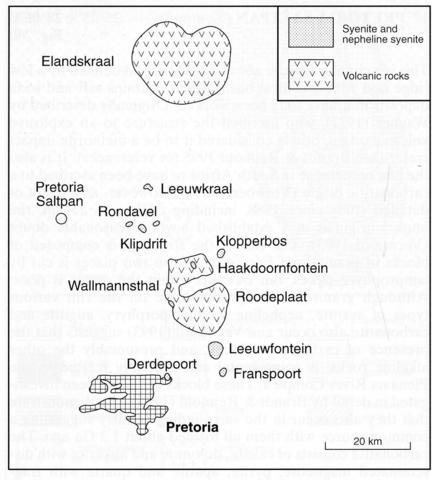stripes
This is a circular feature about 1.1 km across defined by a low ridge and with a central basin which contains salt and soda deposits that have long been worked. Originally described by Wagner (1922), who ascribed the structure to an explosive volcanic origin, others considered it to be a meteorite impact crater (see Brandt and Reimold, 1995 for references). It is also the first occurrence in South Africa to have been ascribed to a carbonatitic origin (Verwoerd, 1993). However, as a result of detailed study since 1988, including drilling to 151 m, the impact origin is now established beyond reasonable doubt (Verwoerd, 1993). The rim of the structure is composed of blocks of granite and Ecca grits and in two places is cut by lamprophyre dykes, but outcrop within the crater is poor. Although granite blocks predominate on the rim various types of syenite, nepheline syenite, porphyry, augitite and carbonatite also occur and Verwoerd (1993) suggests that the presence of carbonatite blocks, and presumably the other alkaline rocks, is coincidental and probably related to the Pienaars River Complex. These blocks have also been investigated in detail by Brandt and Reimold (1995) who demonstrate that they also occur in the surrounding country suggesting a common source with them all formed about 1.3 Ga ago. The carbonatite consists of calcite, dolomite and ankerite with disseminated magnetite, pyrite, apatite and quartz with fragments of chlorite schist scattered throughout. Analyses of this rock are given by Wagner (1922) and Wallace (1976). A porphyry described by Wallace (1976) consists of aegirine and biotite in a very fine-grained groundmass of sanidine, iron oxides, apatite, pyrite and calcite. Nepheline syenite blocks comprise alkali feldspar, grains of aegirine-augite and needles of aegirine, nepheline, amphibole and accessory titanite and cancrinite. Rock and pyroxene analyses are available in Wallace (1976). A detailed account of the deposits occupying the bottom of the crater is given by Wagner (1922).
BRANDT, D. and REIMOLD, W.U. 1995. The petrology of the igneous rocks occurring in the Pretoria Saltpan impact crater and surrounding area. South African Journal of Geology, 98: 304-18.KOEN, G.M. 1955. Heavy minerals as an aid to the correlation of the sediments of the Karroo System in the northern part of the Union of South Africa. Transactions of the Geological Society of South Africa, 58: 281-366.VERWOERD, W.J. 1967. The carbonatites of South Africa and South West Africa. Geological Survey of South Africa, Handbook, 6: 1-452VERWOERD, W.J. 1986. Mineral deposits associated with carbonatites and alkaline rocks. In C.R. Anhaeusser and S. Maske (eds), Mineral deposits of Southern Africa, 2: 2173-91. The Geological Society of South Africa, Johannesburg.VERWOERD, W.J. 1993. Update on carbonatites of South Africa and Namibia. South African Journal of Geology, 96: 75-95.WAGNER, P.A. 1922. The Pretoria Salt-pan a soda caldera. Memoir, Geological Survey of South Africa, 20: 1-136.WALLACE, R.C. 1976. Note on some of the mafic ejecta from the Pretoria Saltpan. Transactions of the Geological Society of South Africa, 79: 191-6.

